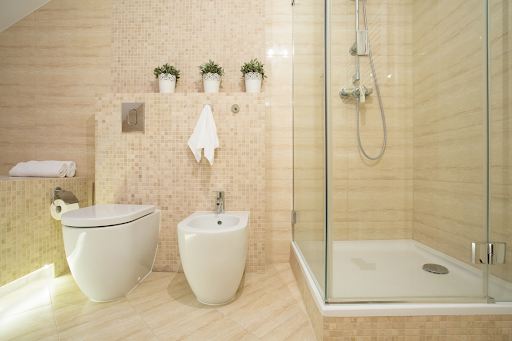Water conservation is a pressing issue, and one area where significant progress can be made is in our bathrooms. Traditional toilets account for a substantial amount of water usage in households. However, with advancements in eco-friendly plumbing technology, waterless and ultra-low flush toilets are emerging as sustainable solutions for the future. In this article, we will explore the benefits of these innovative toilet systems and their role in water conservation efforts.
Waterless Toilets: The Basics
Waterless toilets, also known as dry toilets or composting toilets, operate without the need for any water for flushing. These systems use innovative designs and natural processes to manage human waste efficiently. Instead of relying on water to transport waste to a sewer or septic system, waterless toilets utilise decomposition, evaporation, and aerobic bacteria to break down and transform waste into compost.
Advantages of Waterless Toilets
Waterless toilets offer several advantages in terms of water conservation and environmental impact. Firstly, they eliminate the need for water flushing, which can save a significant amount of water per flush. This conservation becomes especially important in regions experiencing water scarcity or in off-grid locations where water supply is limited. Waterless toilets also contribute to reducing the strain on wastewater treatment systems and minimising the risk of sewage overflows.
Ultra-Low Flush Toilets: Efficient Water Usage
While waterless toilets provide a water-saving alternative, ultra-low flush toilets are another viable option for water conservation. These toilets use advanced engineering and design to minimise water usage without compromising flushing efficiency. Ultra-low flush toilets typically consume around 6 litres or less per flush, significantly reducing water consumption compared to conventional toilets that use 13 to 26 litres per flush.
Dual-Flush Toilets: A Balanced Approach
Dual-flush toilets provide a balanced solution by offering two flush options: a lower-volume flush for liquid waste and a higher-volume flush for solid waste. This design allows users to choose the appropriate flush option based on their needs, further reducing water usage. The liquid waste flush typically utilises around 3 litres of water, while the solid waste flush uses around 6 litres. Dual-flush toilets offer flexibility and water efficiency in one system.
Advanced Toilet Technologies
Beyond waterless and ultra-low flush toilets, advancements in toilet technologies continue to drive water conservation efforts. For instance, vacuum-assisted toilets use air pressure to flush waste, reducing water consumption. Additionally, some toilets incorporate sensors and smart technology to optimise flushing efficiency, ensuring that only the necessary amount of water is used.
Public Perception and Adoption
One challenge in the widespread adoption of waterless and ultra-low flush toilets is the perception and acceptance among the general public. Many individuals still associate waterless toilets with unpleasant odours or discomfort. However, modern waterless toilet systems are designed to be odour-free and hygienic, utilising ventilation systems and separating solid and liquid waste. Educating the public about the benefits and advancements of these technologies is crucial for their acceptance and adoption.
The Role of Regulations and Incentives
Government regulations and incentives play a significant role in promoting the adoption of water-efficient toilet systems. Some states have implemented building codes or certification programs that require or encourage the installation of waterless or ultra-low flush toilets in new constructions or renovations. Financial incentives, such as rebates or tax credits, can also motivate homeowners to switch to more water-efficient toilet options.
Faucet Aerators and Low-Flow Showerheads
Installing faucet aerators and low-flow showerheads are simple yet effective strategies for water conservation in the bathroom. Faucet aerators reduce water flow by mixing air with the water stream, maintaining adequate pressure while using less water. Low-flow showerheads are designed to deliver a satisfying shower experience while significantly reducing water consumption. These fixtures can help save gallons of water every time you use the faucet or take a shower.
Water-Efficient Bathroom Fixtures
In addition to faucets and showerheads, replacing old toilets and sinks with water-efficient models can make a significant difference in water conservation. Look for toilets labelled with the Water Efficiency Labelling and Standards (WELS) label, as they meet strict efficiency criteria. Water-efficient toilets use advanced flushing technology and optimised water flow to minimise water usage per flush. Similarly, choosing low-flow sinks or retrofitting existing faucets with aerators can further reduce water waste in the bathroom.
Greywater Recycling Systems
Implementing greywater recycling systems in the bathroom is an innovative approach to water conservation. Greywater refers to the relatively clean wastewater generated from bathroom sinks, showers, and bathtubs. Greywater recycling systems collect and treat this water for reuse in flushing toilets or irrigating non-edible plants. By recycling greywater, you can significantly reduce the demand for fresh water and contribute to overall water conservation efforts.
Water-Conserving Bathroom Habits
Practising water-conserving habits in the bathroom can amplify your water-conservation efforts. For example, turning off the faucet while brushing your teeth or shaving can save gallons of water per day. Taking shorter showers and using a shower timer to track your time can help minimise water usage. Additionally, fixing leaks in faucets, toilets, or showerheads promptly is crucial to prevent unnecessary water waste.

Education and Awareness
Raising awareness about water conservation in the bathroom is essential for creating a culture of sustainability. Educate family members and household occupants about the importance of water conservation and simple strategies they can implement in their daily routines. Encourage responsible water use and lead by example. Sharing information through educational materials, social media, or community initiatives can also inspire others to adopt water-efficient practices in their bathrooms.
Regular Maintenance and Inspections
Regular maintenance and inspections of bathroom fixtures and plumbing systems are vital to prevent water leaks and identify inefficiencies. Conduct periodic checks for leaks in faucets, toilets, and showerheads. Repair or replace faulty components promptly to prevent water waste. Inspect toilet tanks for flapper valve leaks or running water issues. By ensuring that your bathroom fixtures are in good working condition, you can avoid unnecessary water usage.
Rainwater Harvesting for Toilet Flushing
Another water-saving strategy for toilets is the use of harvested rainwater for flushing. Rainwater harvesting systems collect and store rainwater from rooftops, which can then be used to flush toilets. By diverting rainwater to a separate tank or cistern, you can significantly reduce the reliance on freshwater for toilet flushing. This practice is particularly beneficial in regions with ample rainfall or during the wet season.
Smart Technology Integration
Integrating smart technology into bathroom fixtures can optimise water usage. Smart faucets and showers equipped with motion sensors or touchless controls can provide precise water flow only when needed, reducing waste. Additionally, smart water monitoring systems can track your water usage in real-time, helping you identify areas for improvement and adjust your habits accordingly.
Water Conservation Campaigns and Programs
Participating in water conservation campaigns and programs can foster a sense of community engagement and promote sustainable bathroom practices. Support local initiatives or join national water conservation programs that provide resources, education, and incentives for water-efficient practices. By being part of these collective efforts, you contribute to a larger movement towards water conservation.
Water-Efficient Bathroom Design
When renovating or designing a new bathroom, consider water-efficient design principles. Opt for smaller sinks or dual-flush toilets that offer water-saving options. Position fixtures strategically to minimise water splashing and runoff. Select materials and finishes that are easy to clean, reducing the need for excessive water use during cleaning. A well-planned bathroom design can maximise water efficiency while maintaining functionality and aesthetics.
Waterless and ultra-low flush toilets offer promising solutions for water conservation in our bathrooms. With their innovative designs and technology, these toilet systems can significantly reduce water usage while maintaining flushing efficiency. By embracing these sustainable alternatives, we can contribute to the preservation of our water resources and create a more environmentally-conscious future.




